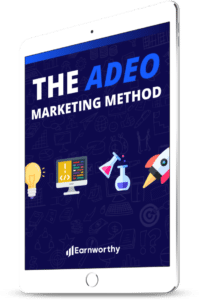Remember back when your website visitors would only enter your site from your homepage, and stare at your popover box until quickly deciding to opt-in to your email list?
Nah, me neither. Marketing just doesn’t work like that.
In reality, your site visitors enter your site through a variety of means. Who knows which page will be their first impression of our brand. Maybe they found one of your blog posts on Google, or maybe they saw a tweet that caught their interest.
It’s all about that conversion rate
Whatever the case may be, as marketers, we have to be ready to and willing to convert visitors into leads and customers regardless of how much they know about our brand, how long they’ve known about us, or (this is important) which page they happen to be on.
How do we do that you ask? Well, there’s one type of page that is quite good at converting visitors to leads and customers. It’s called a landing page! Oh yeah, remember those things?!
And believe it or not, there are folks who study landing pages like crazy. Some call these people conversion rate optimization (CRO) specialists, while others simply call them nerds.
Whatever the case may be, there is a science to building and testing landing pages, and you need to be tapped into it.
Landing pages are built with the end-user in mind. They are built to convert. They are built to be tested. They are built and never finished, because there’s always something else that can be added or subtracted.
Frankly, landing pages are works of art. Okay, I’m getting a little carried away here, but you catch my drift. Landing pages matter, because they sell stuff!
And after all, aren’t we in business to sell stuff? You don’t think I’m blogging just for the fun of it, do you? 😉
Therefore, you need to keep one simple rule in mind when working on your site. You need to…
…Treat Every Page Like a Landing Page!
Now that you know what to do, let me show you how to do it. Let’s look at some of the main characteristics of a good landing page, so that you can see how to use these elements on other pages on your site.
1. Landing pages are focused on one thing
Have you ever visited a page that was just all over the place? I’m talking about banners, images, headline text, comments, you name it! Everything was just jumbled up with no order.
That’s exactly what you want to avoid when designing for maximum conversions. You want to pick one target theme, keyword, concept, idea (whatever you want to call it), and make that the focus of your page.
This works with blog posts, “about us” pages, product pages, and many others. The average visitor should be able to tell you want the page is about using just a few words. If it takes them more than that to explain it, you should go back to the drawing board.
2. Landing pages convey the main idea quickly and effortlessly
On a related note to the point above, great landing pages should pass the “three-second test.” All that means is that if I show you a new page for three seconds, you should be able to give me a general idea of what it’s about.
To do this, you need to take advantage of imagery, headline text, call-to-action buttons, typographical elements, and more. Make the most important stuff stand out. Sounds simple, right?
3. Landing pages are “giving” pages, not “taking” pages
This is actually something I learned from the folks at LeadPages. Here’s what they’re talking about:
The Give/Take Dynamic: Your page can look like one of two things: a giving page, or a taking page.When someone lands on your page, there are certain elements that signal “giving” and certain ones that signal “taking.” A traditional one-step opt-in form signals “taking” right away because people are so used to websites asking for their information that way. Since the opt-in form is not visible until visitors click the button or text, the two-step opt-in signals “giving” when people arrive on the page.
Is your page conveying value to your visitors? Are you teaching them something, or at least offering to teach them something if they opt-in? You need to be very clear with the value proposition of each page on your site.
It could be as simple as asking visitors to opt-in to your email list in return for an awesome free guide. Or maybe you’re offering free shipping on a specific product if they order now. Whatever it is, make sure you’re clearly giving value of some sort, rather than just asking for opt-ins or money.
4. Landing pages have clear calls-to-action (CTAs)
CTAs can be a marketer’s best friend. Use them wisely, and they will help you generate plenty of leads or sales. Overuse them, and they will scare your visitors away. Don’t use them at all, and you’re just missing the boat.
On my site for instance, I have CTAs in the sidebar, post footer, and as an occasional popover. Sometimes however, I’ll bake a CTA right into a post, with a content upgrade.
For maximum conversions, you want your CTA to be as closely related as possible to the main focus of your page. Obviously, this isn’t always possible, especially with blog posts. Most of us don’t have the time to create a separate offer for each and every post.
But if you’re in the ballpark, that’s better than not providing a CTA at all.
5. Landing pages are easy to share
There is a lot of debate as to whether landing pages should have social sharing buttons clearly presented on them. Most traditional landing pages do not have such buttons. The reason being that if you give people too many options, they’re less likely to choose the most important option with is to click on your CTA.
I get that. It’s cool, and it works for pure landing pages, in the traditional sense. But this post is about using a “landing page mindset” on every page of your site. In that case, I think we can safely assume that we want people to talk about and share our site with others.
In essence, social sharing is one of our CTAs, and it may even be our main CTA on a particular page or post. Therefore, we need to make it easy for visitors to take that action. Give them a little push. Ask for a “like” or a retweet. It can’t hurt.
7. Landing pages convey trust
I’ve seen some pretty sketchy landing pages over the years. On some of them I wouldn’t even enter in my zip code let alone my email address.
It amazes me how unaware some marketers or designers can be when dealing with online trust. People buy from those they trust. And trust is earned.
Thus, your page should look clean, professional, and convey some sort of proof that your offer is worth consideration.
Are you an author? Maybe put a small bio with some of your book sales rankings somewhere on the page. Are you a business owner? Add “trust logos” of the professional associations you belong to.
There are a ton of different ways to convey trust on a page. The starting point is how the page looks. Spend the extra bucks on a clean, professional, mobile responsive design. That alone can make a world of a difference.
We covered a lot, didn’t we?
But hey, this is serious stuff. If you want more leads and customers, you have to reevaluate every page on your site.
Of course, you’re going to need to prioritize which pages you change and test. There just isn’t enough time to give equal attention to everything.
So, be sure to use the 80/20 rule, and improve the pages that are bringing in the most traffic before anything else.
And if you’re curious which tools I use to build actual landing pages, I’ve been using Instapage quite a bit lately. I absolutely love it so far. I’ve used several other landing page builders on the market, but nothing is as fun, simple, and effective as Instapage. I highly recommend you check them out.
If you want to get started with a free trial from Instapage, you can sign up in seconds and start building by clicking here (affiliate link).
As always, let me know what you thought of this post. Do you already use these tips on your site, or is there another suggestion you’d add to the conversation? Feel free to share below!





